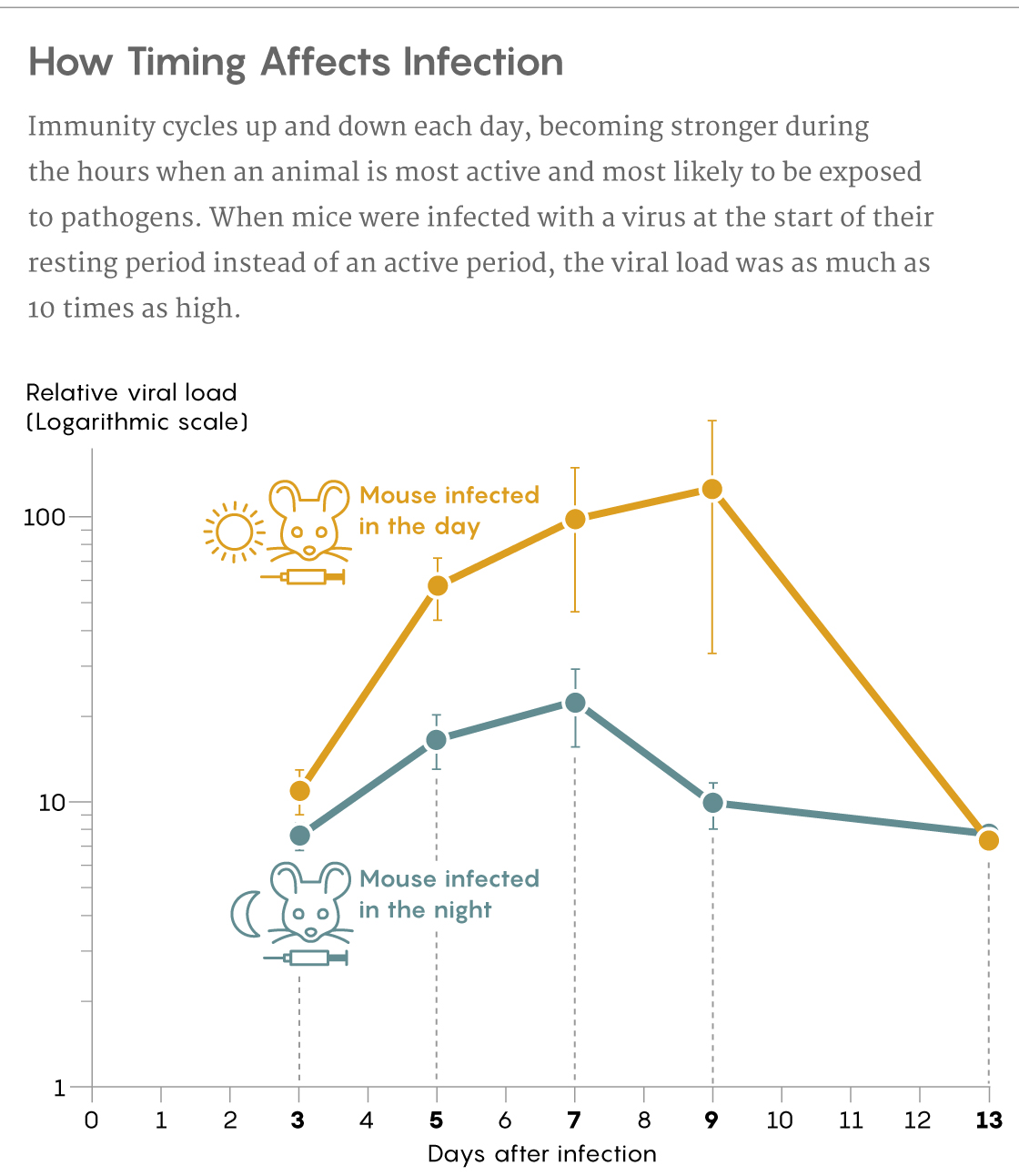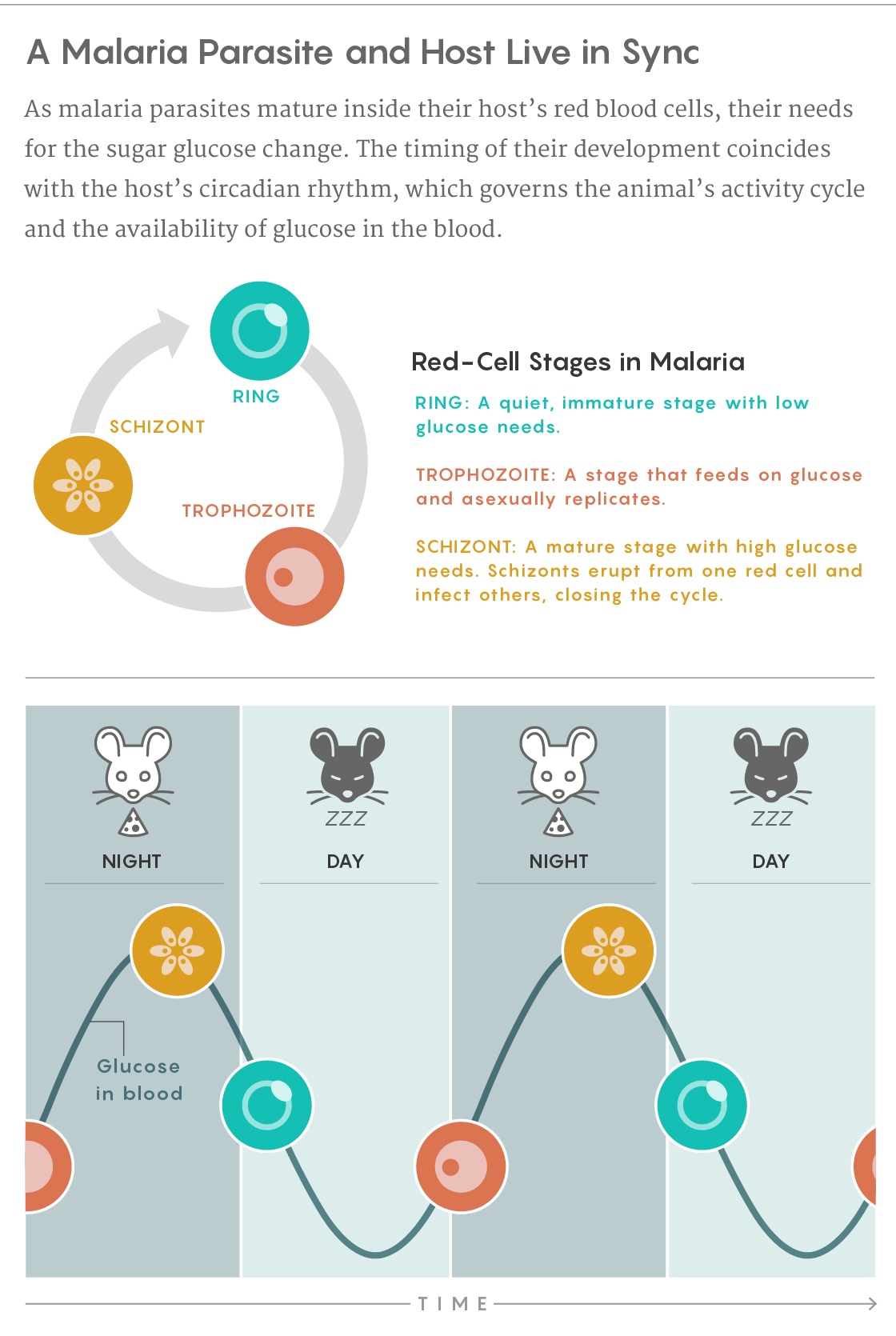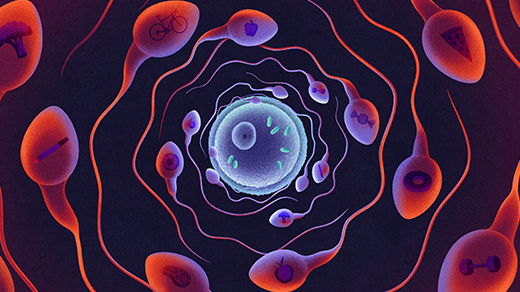The Body’s Clock Offers a Rhythmic Target to Viruses

Circadian rhythms exert a powerful influence over the physiology of organisms. Research is revealing how parasites may attempt to synchronize with — or disrupt — the body clock of their host to gain an advantage.
Ricardo Bessa for Quanta Magazine
Introduction
For at least 3,000 years, humans have known that malaria runs like clockwork, with a devastating fever that peaks, fades and returns on a predictable schedule. The Greek physician Hippocrates observed that it took 24-, 48- and 72-hour forms, and that the daily variety was more deadly than the tertian (second-day) and quartan (third-day) fevers, though all could kill. Later medical authorities had their own theories about this periodicity: The ancient Romans supposedly believed that demons of air, water and earth controlled the separate fevers, and that they fought cyclic battles with the demon of cold. Even up until the late 19th century, doctors tried to explain malaria’s cycling with atmospheric temperature.
After scientists realized that different species of malaria protozoans were behind the fevers, more became clear: The fevers came at the culmination of malaria’s asexual replication phase, when host blood cells turn into sacs bursting with parasites. In 2018, however, the evolutionary parasitologist Sarah Reece at the University of Edinburgh and her colleagues reported an intriguing new detail absent from the centuries of earlier accounts: The timing of this phase of the malaria parasite life cycle seemed to be linked to the circadian rhythms of the host.
“What we’ve been learning is that these cycles are organized to allow the parasite to acquire resources from the host’s food,” Reece said. “We think the parasites are organizing themselves.”
Reece and other scientists are exploring an idea that is making waves in biology: If the body is on a circadian clock, then invasion of the body — whether by a parasite, virus or bacterium — may be governed by a clock as well, either in the host or in the invader. Embracing this may lead to a reconception of the basic biology of infection and immunity as a time-sensitive dynamic that varies with the hour of the day.
The sleep cycle is only the most obvious example of the daily rhythms that organisms have. On a molecular level, one time of day is not like another: not for liver enzymes (which regularly rise and fall in concentration), not for dividing skin cells (which vary their pace of replication) nor for any number of other biological subsystems. In mammals, a message from a light-sensitive region of the brain sets trillions of tiny clocks, one in almost every cell of the body, ticking on their 24-hour cycle. The clocks consist of proteins that act as timers for the expression of thousands of genes. In one recent estimate, more than 80 percent of the protein-coding genes in mammals may be expressed cyclically, with high levels at certain times of the day and low levels at others.
Some of these genes relate to the immune system. For instance, one pair of proteins involved in the clock, REV-ERBα and REV-ERBβ, tightly control the expression of genes key to the function of macrophages, the body’s attack cells. Another set of clock proteins, the CRYs, regulate genes involved in inflammation, an early line of defense against an infection. CRY1, which cycles in abundance throughout the day, holds the activation of inflammatory factors in check; its absence tips a molecular system that boosts the production of these substances.
The manufacture of white blood cells, or leukocytes, also seems to be regulated by the clock. The number of these cells in circulation varies over the course of the day: Studies have shown they are more plentiful at the beginning of an organism’s rest period — at night for humans, for example, and in the morning for nocturnal mice and hamsters. What’s more, the leukocytes move around the body at defined, apparently well-timed intervals.
“You have leukocytes that go to specific organs, for example lymph nodes, in a rhythmic manner,” said Christoph Scheiermann of the University of Geneva, who studies the circadian dynamics of white blood cells. The leukocytes are not everywhere at once; they seem to get cues to head out at certain times.
Perhaps the immune system runs according to a clock because an animal is more likely to encounter a challenge while it is abroad in the world than when it’s asleep. It may also be that keeping the immune system on high alert at all times has downsides that the body avoids by letting its defenses relax regularly.
The Right Time for an Infection
It follows, then, that invaders might get a leg up or be knocked down by lows and highs in the immune system’s activation, by the availability of exploitable host resources or by myriad other factors that the clock controls. “The cellular environment changes so dramatically over the course of 24 hours … [the pathogens] would encounter cellular environments that were either more or less conducive to replication and viral dissemination,” said Rachel Edgar of Imperial College London, who has studied the effect of time of day on viral infection.
To investigate that hypothesis, Edgar and her collaborators exposed mice to herpesvirus at different times. They found that the peak viral load — that is, how much the viruses were replicating — was 10 times as great in mice exposed at the beginning of their resting period as in those exposed at the beginning of their active period. Yet when they repeated the experiment with mice engineered to lack BMAL1, one of the core clock proteins, the active period’s protective effect disappeared: In cells without a working clock, both times were equally good for the virus.

5W Infographics for Quanta Magazine
Curious about whether this difference was caused by cycling in the immune system or by some other manifestation of the clock in a whole animal, Edgar’s team infected mouse cells isolated in a dish. These cells showed the same pattern, with one time of day being better than the other for the virus’s growth, which suggested that some cyclically recurring state of the host cell was important.
What’s more, they discovered that the virus interfered with the host’s expression of BMAL1. About six hours after infection, regardless of what time that was, the virus provoked a spike in the host cell’s BMAL1 levels. It’s difficult to be certain why this happens, but potentially, a disruption of the host cell’s clock might be to the virus’s benefit.
Have viruses evolved to manipulate the host’s circadian clock? It would certainly be a tempting prospect: “If you target the clock, you can change a whole raft of intracellular systems at one fell swoop. You can change the activity of translation, transcription, metabolism — you can reprogram the cell very efficiently,” Edgar reflected.
Different Clock-Based Strategies
Happenstance has led many researchers to studies of the body clock; sometimes after getting frustratingly erratic results from an experiment, they may have discovered that it mattered at what time of day they started a process. That is what brought Jane McKeating of the University of Oxford Medical Sciences Division to this subject: She and her colleagues noticed peculiar variation in a clinical trial of hepatitis C patients. When patients received a liver transplant, the virus always reinfected the new organ, but the pace of this infection was inconsistent. Eventually, one suggestive correlation emerged: “The time of transplantation seemed linked with what was happening,” she said.
Indeed, in a recent paper, McKeating and her colleagues confirmed that it was easier for the hepatitis C virus to enter cells at certain times of day. During the infection process, they found, the virus uses proteins on liver cells that are expressed only at specific times. When the researchers genetically knocked out the cells’ ability to make BMAL1 and boosted REV-ERBα, they also brought down the levels of the surface proteins and protected the cells from infection.
Then when the researchers exposed the knockout cells to dengue and Zika, the lack of BMAL1 also severely hampered those viruses’ ability to replicate. That suggests that BMAL1 might someday be a therapeutic target for keeping certain kinds of viruses out.
The same manipulation of the clock might have different effects, however, depending on the virus involved. A lack of BMAL1 worked out well for the herpesvirus, but wasn’t so good for the viruses in McKeating’s study. Such variation might be the rule rather than the exception. Each virus — or bacterium, or parasite — has its own biology, its own ways of achieving its goals. If there are universals among their tactics, they are probably linked to shared evolutionary history or shared strategies for hijacking a host.
A Temporal Atlas of Viruses
When it comes to the parasites that Reece and her colleagues study, the strategies for a successful invasion involve timing the pathogen’s needs to the host’s daily behavior. In malaria, the first phase of infection sees the parasite getting comfortable inside host blood cells. It collects the raw materials needed to start reproduction. But before it can replicate and let its progeny erupt out to infect new cells, the malaria parasite needs to feed. This is where the circadian rhythm comes in.

5W Infographics for Quanta Magazine
In experiments, when the mice were active and feeding during the night as usual, the newly made parasites burst forth during the night, too. But if Reece and her colleagues fed the mice during the day instead, the parasite completed its cycle in the middle of the day.
“The parasites are organizing their development through the cycle,” Reece said, so that when they are most hungry will coincide with when the most food is entering the bloodstream from the host’s feeding. If the parasite’s cycle shifts and it bursts out at a less optimal time, the parasite doesn’t replicate or transmit as well, which suggests that the usual timing carries a survival benefit.
Reece and her collaborators wonder if this phenomenon goes beyond malaria — indeed, beyond the phenomenon of disease. When a parasite, whether it’s a wasp, a worm or any other hitchhiker, climbs aboard a host, it will do all it can to gain an edge, including manipulating host behavior. Timing its life cycle to leech off a host efficiently, taking advantage of weak moments in the immune system’s cycle and perhaps even altering a host’s circadian clock could be strategies in any parasite’s playbook.
The trick will be to see whether these insights can be turned back against the invaders. Already, a few studies have suggested that vaccines given at the right time of day produce a more robust immune response. Perhaps scientists will eventually be able to use an understanding of the circadian clock to optimize the use of pharmaceuticals — ensuring that some vaccines don’t need supplementary boosters to become fully protective, for example, or guiding the dosage times for medications to best effect.
Edgar lays out a grand vision of a temporal atlas of viruses, cross-referenced according to what they do and when. In this mapping, the viruses that use one cyclically expressed protein to get into a cell will be together. Those that thrive at night and are sluggish in the morning will be identified as such, like those that use a given host metabolic pathway to jump-start their growth.
Someday, it may be possible to look at a new pathogen and understand from an analysis of its features how it will respond to the time of day.
“But,” she noted, “it will take awhile.”
This article was reprinted on TheAtlantic.com.



